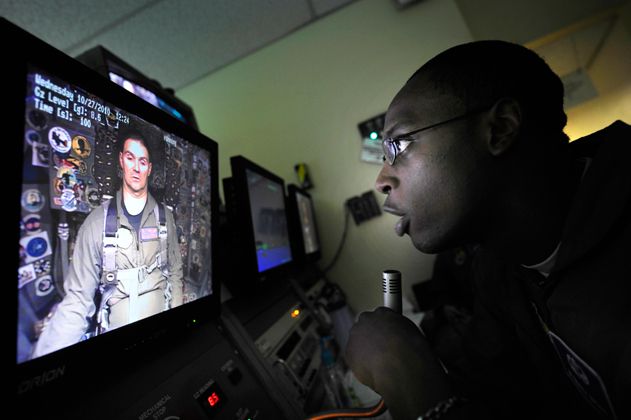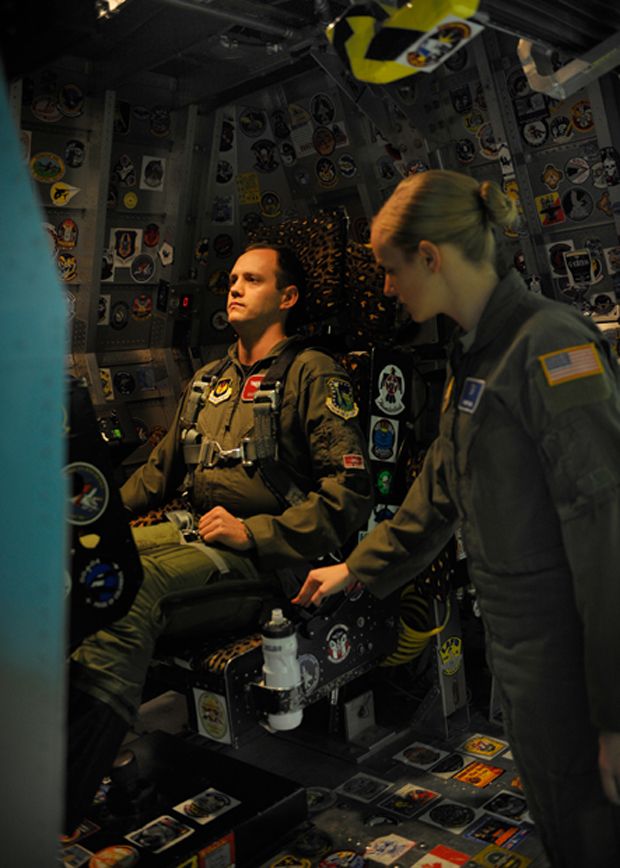Spin Down
Thousands of Air Force pilots trained on the Holloman centrifuge. Now a better ride is coming.
/https://tf-cmsv2-smithsonianmag-media.s3.amazonaws.com/filer/centrifuge-flash.jpg)
Tech Sergeant Carlos Rivera has been training fighter pilots for five years. He’s not a pilot, and he doesn’t teach his students how to fly. He teaches them how to keep blood flowing to their brains during high-G maneuvers—by tensing, among other things, their butt muscles.
Up until recently, Rivera’s main teaching tool was the centrifuge at Holloman Air Force Base in New Mexico. Students call it the Spin ‘N Puke, but he says it’s a misnomer; most high-G maneuvers push the contents of your stomach down, not up. Recently, after more than 20 years of service, the Spin ‘N Puke’s long career came to an end. Rivera was present on October 27 when the centrifuge took its final spin, and its final student, an F-22 pilot from the Royal Air Force named George Cannon, was slammed into his seat with nine times the force of gravity.
“It was special because it was the last one,” says Rivera. “You know, I had been doing this for a long time.”
In operation since 1988, the Holloman centrifuge and its crew trained most of the U.S. Air Force pilots who fly high-performance fighter jets, as well as pilots from other countries that don’t have their own facilities. But after training nearly 32,000 students, the facility has been shut down as part of a directive by the DoD’s Base Closure And Realignment Commission. The plan is to consolidate biomedical research (which has been done using a centrifuge at Brooks City-Base in San Antonio, Texas) and pilot training into a single new centrifuge under construction at Wright-Patterson AFB in Ohio. Until that facility opens in September 2012, both missions are being carried out at Brooks.
The idea of the centrifuge is pretty straightforward: Pilots sit in a pod or gondola attached to a motorized arm, and the arm swings them in a circle so fast that they experience G-forces similar to those they’ll feel in a high-performance aircraft. Rivera’s was one of the voices Holloman students would hear as the centrifuge turned their faces into Edvard Munch paintings. He would talk them through their breathing, remind them to tense their muscles, and give them tips on how to improve their AGSM.
The Anti-G Straining Maneuver is a practice fighter pilots depend on for their lives. Say you’re banking hard at several hundred miles per hour. Your eyeballs receive oxygenated blood from the center out, so as blood drains from your head toward your feet, your vision starts to gray around the edges. A dark tunnel closes in until you can’t see. Then you pass out. This is called G-LOC, or G-force-induced loss of consciousness. A-LOC, or almost-loss of consciousness, can be just as dangerous, causing disorientation, vision and hearing problems, even temporary paralysis. Not something you want to experience while backing out of your driveway, let alone flying a fighter jet.
To avoid these problems, centrifuge technicians teach students to tense their lower-body muscles, which blocks blood from flowing away from the brain and lungs. The students also learn to hold air in their lungs to keep a reserve of oxygen, and breathe only in quick, shallow exchanges. If they don’t, the G-force compresses their lungs, they can’t get a good breath in, and it’s lights out.
Rivera learned tricks of the trade from the Holloman techs who came before him, like watching the gondola’s video monitor for flaring nostrils or chest movement—signs that a trainee isn’t doing the breathing exercises correctly.
All technicians are required to undergo high-G centrifuge sessions themselves before they begin training students. That helps them understand the physiology of a high-G maneuver and better appreciate what the trainees are going through, which makes them better teachers, says Rivera. “If you’re going in there and you’ve never done it before, and you’re trying to talk to someone that’s struggling, it’s kind of hard to get through to them.”
In that spirit, techs-in-training deliberately G-LOC so they know what it feels like. They do this by cranking the centrifuge up to 9 Gs and simply breathing normally. Rivera says it takes about seven seconds to lose consciousness with that G-load. “Two normal breaths and you’re done.”
Regaining consciousness after a G-LOC is disorienting, similar to waking up from a nap. It can take a few seconds for trainees to figure out what’s happened and where they are. Rivera says one of his students woke up thinking she was in her bed back in San Antonio, worried that she was late for school.
Some students post video of their centrifuge training sessions on YouTube, which opens them up to jokes about their performance. But for fighter pilots, AGSM training can be a matter of life and death. In March 2009, an F-22 test pilot flying out of Edwards AFB was killed after he A-LOC’ed during a high-G maneuver. His fighter plummeted toward the ground as he tried to regain his focus, but it was too late.
“You gotta think that the AGSM is only a small piece in their pie when they’re trying to think about fighting maneuvers,” says Rivera. “We try to make this training so intense and so ingrained into their body and their muscle memory that it comes as second nature to them. Because if they’re doing all these other maneuvers… and they start pulling Gs, the possibility of them G-LOC’ing and people dying and losing aircraft just increases exponentially.”
Most of the centrifuge training crew from Holloman will move to Wright-Patterson, along with the researchers from Brooks. Rivera, though, will be staying on at Holloman to help with safety protocols. Among other things, he’ll be checking in on the pilots to make sure their AGSM stays sharp.
Rivera says he and his colleagues are excited about the future of centrifuge training. For one thing, the facility at Wright-Patterson will feature a few technical improvements over the ones at Holloman and Brooks. The new centrifuge will be able to swing its gondola in any direction, allowing trainees to simulate Gs in a number of thrust vectors. While some researchers study how the body is affected by different types of G forces, others will be able to test equipment like compressive G-suits that help pilots keep blood in their upper bodies.
Overall, Rivera thinks the combination of research and training will be a plus for both. “[Centrifuge work] has been slowly developing, it’s been improving,” he says. “We’re trying to make this program the best program out there.”

